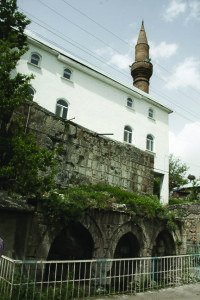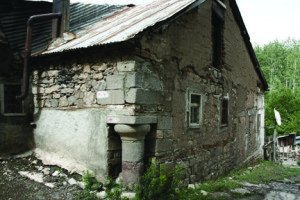I took each step with caution, placing one foot in front of the other with the precision of a tightrope dancer. I carefully traced the edge of the crumbling wall, where the earth was dry. Just a few inches to my right was the stew of mud, manure, and urine that carpeted the interior of what was once a church, today a barn. We were in Baglarpinar, once called Darman. I could hear men talking in Turkish behind me. At that moment, I did not care who they were, how they had congregated there that fast, or what was being said. I needed to walk alongside those walls. Later, my colleague Khatchig would tell me, “They were asking, ‘Why is that woman in there?’”

Why was I in there? It was silly, really. One wrong step and I would have been ankle deep in feces. Why were we driving through these villages in search of anything from our past, anything Armenian? Only an hour earlier, as we had entered Adakli—known to us as the fortress of the stars, Asdghapert—we had been given a warning by an old man. We had asked whether any Armenian churches still stood, in Adakli. “If you ask such questions here, they will throw you off a cliff,” he had told us before jumping in the front seat of our van and directing us to the old Armenian fountain in town.
We saw the fountain, and the spray painted sign—MHP—the acronym for the ultra-nationalist party in Turkey. We saw the small monastery attached to the fountain, and the new mosque that was built on top. Inside the monastery, we saw crosses engraved in the walls, and a book-size fragment of a cross-stone (khatchkar). We had to leave fast. Our presence was raising suspicion. This was Bingol province, where clashes between PKK fighters and the Turkish Army are far too common. The hostility level towards us was also markedly higher than anywhere else we had been to so far.

As we left Baglarpinar, Khatchig’s voice pulled me out of the maze of questions my mind had wandered into. “Perhaps they’ll think you know where gold was hidden…maybe it’ll prompt them to dig. In the process, they’ll clean the filth,” he said. We smiled sadly. “Do I look like someone who’s here to dig for gold?” I murmured.
Apparently, I did. Why else would two Armenians search for crumbling churches? It soon became clear how suspicious we had seemed, when in Keghi we were confronted by two Turkish military officers who pulled up next to us in an armored vehicle. Someone in Adakli had reported us, said the tall man clad in a bullet-proof vest, as his smaller companion stood by his side, machine-gun in hand. After a brief interrogation, and after they inspected our passports, we were allowed to leave. Before we could even begin to discuss what had just happened, we were stopped by yet another vehicle. This time it was the chief of police, and another officer—both clean-shaven, and in plainclothes. They wanted to check my camera. They zipped through the donkey pictures, the pictures of us standing next to the walls of houses, the old stonewall by a garden, and the stream with the floating trash. He handed the camera back to me, and with a few words of advice (and after telling us that there were those who dig for gold in the area, and that it was his job to stop them), he let us go.

I wanted to hand him back the camera. I wanted to zoom into my pictures to show him how on the walls of the houses, the Armenian cross-stones had survived. You could clearly see the crosses! The massive column supporting that village house most likely bore the weight of the church at one time. The stone wall enclosing the garden? That was the church! Wasn’t it obvious? We were hunting for treasure! We were guilty!
We left Keghi, drove through the mountains, back-tracking our nearly five-hour long journey from Diyarbakir. We drove through and by villages. We saw old and new structures. I wanted to stop at every turn, see every stone.

The sun was falling fast. We had been warned against lingering in the area after dark. The stones called me back. I know it won’t be long before I answer their call—even if that means falling into shit.


THANK YOU for 1 of your very best trips & tales, MS. NANORE,
As we kick our way through all the shit…
MIKE ADAJIAN
Yes, Nanore, absolutely; you are always followed. Sometimes, it is obvious as it was when armed guards stopped you and Khatchig, but most often it’s plain clothes men. They don’t follow singly. They follow in groups. When I was in Bingol, no one bothered me as I scooped up a small pail of the red soil to bring back, but very soon afterwards, a man came up and photographed us. I was also photographed at Ani. I’m beginning to feel like an older Kardashian! Several police cars escorted us out of Bingol.When we asked why, we were told it was to ensure our safety! If you examine the fronts of the buildings on the main street in Bingol, across from the mosque, you will see Armenian inscriptions still visible in the stones near the tops of several of the buildings. Both your article and Khatchig’s makes clear that even the most innocuous act can bury you in “shit,” even when you are doing nothing more than just looking. Glad you got back safely.
Thank you, seeing this reminds me of my father’s stories of life there. He came from the village of Khoubek in Keghi.
I am from kiğı.I vont tuo meet you
Someone had made the following comment somewhere I do not remember. Ir read: “Armenians visit Armenia as a tourist but visit Turkey as a spiritual journey”. Does it not ring true?
I believe a poor Armenian woman and her children on the famous photograph reposited in the Library of Congress (http://www.loc.gov/pictures/resource/ggbain.27081/) were from Keghi. In 1899, after the murder of her husband in the aftermath of the Hamidian massacres of 1894-1896, the woman and her two daughters: Markarid (on her back) and Nvart (standing next to her), walked from their home in the Keghi region to Kharpert (Harput), seeking refuge from Christian missionaries.
Can someone explain to me: is Keghi a town near Asdghapert? Or is Keghi a province and Asdghapert is in it?
My father came from Asdkhapert and I always always thought it was a town and Keghi was a region or province. Am I wrong? His family owned approximately 150 acres of land there
Hi. İm from Darman (temran)
Do you know soöebody who was born in Darman?
Keghi is a county and there is the town of Keghi (the county seat of government in Keghi). Prior to the Genocide, it was in the vilayet of Erzeroum; later the Turks redistricted it into Bingol. Both my mother and father were born in Darman (one of the larger villages in Keghi prior to the Genocide with an Armenian population numbering over 2,800 and about 80 Kurds). The desecrated Church in Darman was named St. Sarkis and rebuilt and enlarged in the mid 18th century. I made my pilgrimage to Darman in 1976 and at that time the four walls of the Church were still standing showing the 3 niches for the main and 2 side altars; the roof was missing. The Kurds had piled manure in the main door over which you could still see the name of it in Armenian letters. I also met an old Kurdish man who said he was a young boy when the Armenians lived there, but one morning they woke up to find that “ALL THE ARMENIANS HAD MOVED AWAY”!!! He even spoke to me in the colloquial Keghetzee Armenian. He named many of the families including mine.
I visited Asdkhapert in 1976 and shot a 15-minute video which I’d be happy to share with anyone who is interested. My Father was born there and came to Canada in 1911 and went back to Turkey in 1919 where he met my Mother in Adana, married her and brought her back to Brantford, Ontario, Canada where they settled and raised a family. I am retired and live in Los Angeles. John Noubarian, who was one of your respondents is my dear friend.